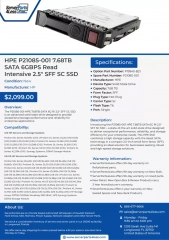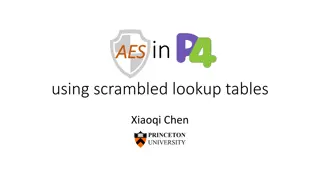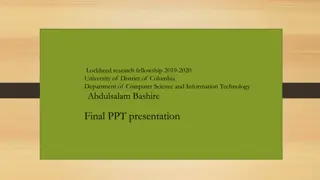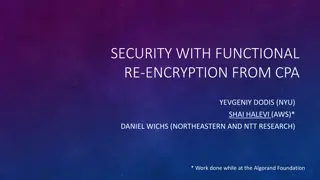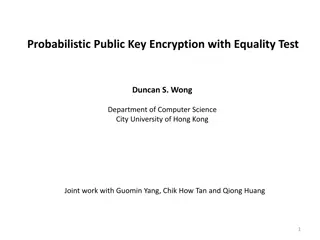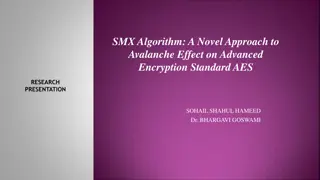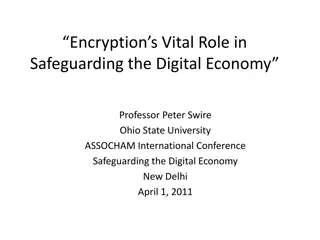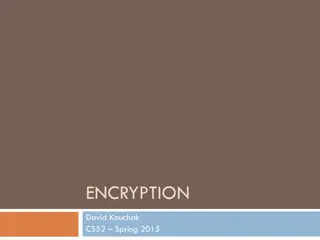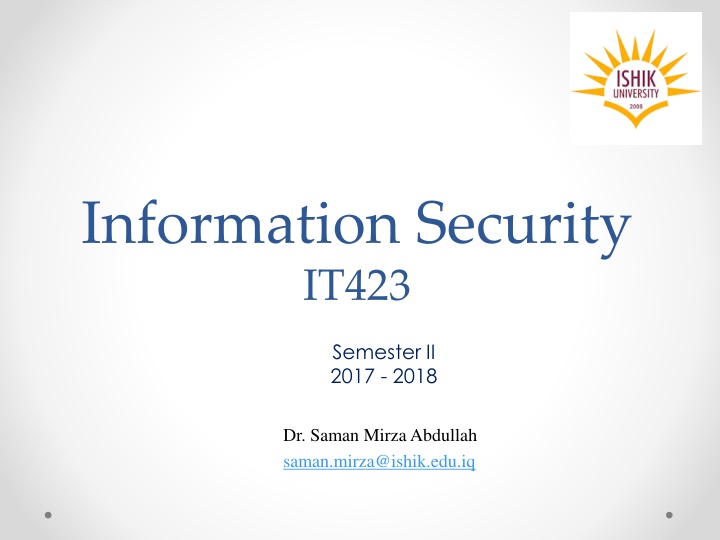
Symmetric Encryption and Cryptography Basics
Dive into the world of information security with a focus on symmetric encryption algorithms, block and stream encryption, classical ciphers, and the fundamental terminology of cryptography. Explore the classification of cryptography, encryption operations, and the requirements for secure symmetric encryption. Enhance your knowledge of encryption principles and methods in computer security.
Download Presentation

Please find below an Image/Link to download the presentation.
The content on the website is provided AS IS for your information and personal use only. It may not be sold, licensed, or shared on other websites without obtaining consent from the author. If you encounter any issues during the download, it is possible that the publisher has removed the file from their server.
You are allowed to download the files provided on this website for personal or commercial use, subject to the condition that they are used lawfully. All files are the property of their respective owners.
The content on the website is provided AS IS for your information and personal use only. It may not be sold, licensed, or shared on other websites without obtaining consent from the author.
E N D
Presentation Transcript
Information Security IT423 Semester II 2017 - 2018 Dr. Saman Mirza Abdullah saman.mirza@ishik.edu.iq
Learning Objectives After studying this chapter, you should be able to: oExplain the basic operation of symmetric block encryption algorithms. oCompare and contrast block encryption and stream encryption. Computer Security - Ishik 2
Outline Overview of Cryptography Classical Symmetric Cipher Computer Security - Ishik 3
Basic Terminology plaintext - the original message ciphertext - the coded message cipher - algorithm for transforming plaintext to ciphertext key - info used in cipher known only to sender/receiver encipher(encrypt) - converting plaintext to ciphertext decipher (decrypt) - recovering ciphertext from plaintext cryptography - study of encryption principles/methods cryptanalysis(codebreaking) - the study of principles/ methods of deciphering ciphertext without knowing key cryptology - the field of both cryptography and cryptanalysis Computer Security - Ishik 4
Classification of Cryptography Number of keys used o Hash functions: no key o Secret key cryptography: one key o Public key cryptography: two keys - public, private Type of encryption operations used o substitution / transposition / product Way in which plaintext is processed o block / stream Computer Security - Ishik 5
Outline Overview of Cryptography Classical Symmetric Cipher o Substitution Cipher o Transposition Cipher Computer Security - Ishik 6
Symmetric Cipher Model Computer Security - Ishik 7
Requirements Two requirements for secure use of symmetric encryption: o a strong encryption algorithm o a secret key known only to sender / receiver Y = EK(X) X = DK(Y) Assume encryption algorithm is known Implies a secure channel to distribute key Computer Security - Ishik 8
Classical Substitution Ciphers Letters of plaintext are replaced by other letters or by numbers or symbols Plaintext is viewed as a sequence of bits, then substitution replaces plaintext bit patterns with ciphertext bit patterns Computer Security - Ishik 9
Caesar Cipher Earliest known substitution cipher Replaces each letter by 3rd letter on Example: meet me after the toga party PHHW PH DIWHU WKH WRJD SDUWB Computer Security - Ishik 10
Caesar Cipher Define transformation as: a b c d e f g h i j k l m n o p q r s t u v w x y z D E F G H I J K L M N O P Q R S T U V W X Y Z A B C Mathematically give each letter a number a b c d e f g h i j k l m 0 1 2 3 4 5 6 7 8 9 10 11 12 n o p q r s t u v w x y Z 13 14 15 16 17 18 19 20 21 22 23 24 25 Then have Caesar cipher as: C = E(p) = (p + k) mod (26) p = D(C) = (C k) mod (26) Computer Security - Ishik 11
Cryptanalysis of Caesar Cipher Only have 25 possible ciphers o A maps to B,..Z Given ciphertext, just try all shifts of letters Do need to recognize when have plaintext E.g., break ciphertext "GCUA VQ DTGCM" Computer Security - Ishik 12
Monoalphabetic Cipher Rather than just shifting the alphabet Could shuffle (jumble) the letters arbitrarily Each plaintext letter maps to a different random ciphertext letter Key is 26 letters long Plain: abcdefghijklmnopqrstuvwxyz Cipher: DKVQFIBJWPESCXHTMYAUOLRGZN Plaintext: ifwewishtoreplaceletters Ciphertext: WIRFRWAJUHYFTSDVFSFUUFYA Computer Security - Ishik 13
Monoalphabetic Cipher Security Now have a total of 26! = 4 x 1026 keys Is that secure? Problem is language characteristics o Human languages are redundant o Letters are not equally commonly used Computer Security - Ishik 14
English Letter Frequencies Computer Security - Ishik 15
Example Cryptanalysis Given ciphertext: UZQSOVUOHXMOPVGPOZPEVSGZWSZOPFPESXUDBMETSXAIZVUEPHZHMDZSHZOWSFPAPPDTS VPQUZWYMXUZUHSXEPYEPOPDZSZUFPOMBZWPFUPZHMDJUDTMOHMQ Count relative letter frequencies (see text) Guess P & Z are e and t Guess ZW is th and hence ZWP is the Proceeding with trial and error finally get: it was disclosed yesterday that several informal but direct contacts have been made with political representatives of the viet cong in moscow Computer Security - Ishik 16
Transposition Ciphers Now consider classical transposition or permutation ciphers These hide the message by rearranging the letter order, without altering the actual letters used Can recognise these since have the same frequency distribution as the original text Computer Security - Ishik 17
Rail Fence cipher Write message letters out diagonally over a number of rows Then read off cipher row by row E.g., write message out as: m e m a t r h t g p r y e t e f e t e o a a t Giving ciphertext MEMATRHTGPRYETEFETEOAAT Computer Security - Ishik 18
Product Ciphers Ciphers using substitutions or transpositions are not secure because of language characteristics Hence consider using several ciphers in succession to make harder, but: o Two substitutions make a more complex substitution o Two transpositions make more complex transposition o But a substitution followed by a transposition makes a new much harder cipher This is bridge from classical to modern ciphers Computer Security - Ishik 19
Quiz ONE Suppose that someone suggests the following way to confirm that the two of you are both in possession of the same secret key. You create a random bit string the length of the key, XOR it with the key, and send the result over the channel. Your partner XORs the incoming block with the key (which should be the same as your key) and sends it back. You check, and if what you receive is your original random string, you have verified that your partner has the same secret key, yet neither of you has ever transmitted the key. Is there a flaw in this scheme? Computer Security - Ishik 20
Class End Computer Security - Ishik 21

